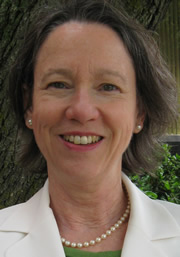Reducing the Risk of Breast Cancer
Air Date: Week of May 16, 2014

Pumping gas can increase exposure to breast cancer-causing chemicals. (Photo: Big Stock)
A recent study from the Silent Spring Institute catalogued common pollutants and chemicals that increase breast cancer risk. The Institute’s Executive Director, Dr. Julia Brody, tells host Steve Curwood how to minimize exposure to these carcinogens and so reduce the risk.
Transcript
CURWOOD: From the Jennifer and Ted Stanley Studios in Boston and PRI, this is Living on Earth. I’m Steve Curwood. Here's a sobering fact - breast cancer is the leading cause of death among US women between the late 30s and early 50s, and rates are rising. And though obesity and genetics account for some of the risks, much of the danger comes from repeated exposure to certain chemicals in our homes, air and water. Research just published in Environmental Health Perspectives identifies the most frequently encountered breast carcinogens and suggests ways people can reduce their exposure. Julia Brody is Executive Director of the Silent Spring Institute in Newton, Massachusetts, and a co-author of the paper. She joins me now to explain how the research was done.
BRODY: We assembled a list of all the chemicals that have been shown in animal studies to increase mammary gland tumors, and there are about 216 of those chemicals. Then we narrowed it down to the ones that women are most commonly exposed to, and set a priority on 100 chemicals that are very common, and women are exposed to every day.
CURWOOD: So what kinds of chemicals are you talking about here?
BRODY: We’re talking about chemicals that are in air pollution, diesel exhaust, gasoline, perfluorinated compounds - those are in non-stick and stain resistant surfaces - some flame retardants and a variety of chemicals that are in consumer products and workplaces.

Pumping gas can expose people to carcinogens linked to breast cancer (Photo: Big Stock)
CURWOOD: Out of your study, you developed seven tips to reduce exposure to likely breast carcinogens. First thing you mention is to lessen exposure to fumes from things like gasoline.
BRODY: I will say that I think it’s very important for people to understand that air pollution is actually a breast cancer issue. One of the most important areas we found was the number of breast carcinogens in gasoline and in auto exhaust and diesel exhaust. We can each reduce our exposure to these by reducing use of gasoline, for example by getting an electric lawn mower or high-efficiency vehicle. And we can also take action at the community level. For example, you often see buses or cars idling in front of a school, and if those engines are turned off, then the kids and the parents who are picking them up are not exposed so much to these breast carcinogens, these chemicals in gasoline and vehicle exhaust include benzene and polycyclic aromatic hydrocarbons (PAHs). These are priorities on our list of breast carcinogens.
CURWOOD: Now, what about at the cook stove?
BRODY: There are two things you can do. One is to turn on the ventilation fan so you’re exhausting the PAHs and the smoke out of your house. The other thing is to cook at a lower temperature so you’re not creating char on your food, delicious as it may be, it does contain breast carcinogens, and if you just cook at a lower temperature, or marinate before you cook, that will reduce your exposure.
CURWOOD: You say there are risks with dry cleaning. What should one do?

Breast Cancer Cells (photo: Wikimedia Commons)
BRODY: Nowadays it’s not too hard to find a drycleaner who will do what’s called “wet-cleaning”, so ask your drycleaner if they have a method that doesn’t use PERC, perchloroethylene, or other solvents.
CURWOOD: What about drinking water?
BRODY: Well, of course, we want our drinking water to be free of any pathogens that might cause sickness. But in the process of disinfecting water, we’re inadvertently sometimes creating carcinogens and we found that, for example, MX is created from the process of chlorinating drinking water. A solid carbon block filter will remove that so you can reduce exposure in your home by installing a solid carbon filter.
CURWOOD: You have some advice about furniture and rugs and that sort of thing. What is that?
BRODY: Some of the chemicals that are used in non-stick and stain resistant surfaces and also flame retardants in polyurethane foams are on our breast carcinogens list. We really need manufacturers to figure out a better way to make things - we don’t need these chemicals in our products, and meanwhile you can avoid stain resistant furniture and fabrics and avoid polyurethane foam or now you can ask for foam that doesn’t have these flame retardants in it.
CURWOOD: And you have some advice around housecleaning.
BRODY: Yes, many of these chemicals that are in consumer products end up in house dust, and we inadvertently end up eating it. Kids, of course, are especially exposed to house dust, because they’re crawling around on the floor and putting their hands in their mouth. But even adults are actually consuming a fair amount of house dust, so one way to reduce your exposure to toxic chemicals is to keep dust levels low by wiping with a wet rag or wet mop or using a vacuum with a HEPA filter. And you can keep the carcinogens that are outside out of your house by putting in a rug just inside your doorway and taking off your shoes when you come house.

Julia G. Brody, PhD, Executive Director at the Silent Spring Institute is a co-author of the research paper on breast carcinogen exposures published in Environmental Health Perspectives (Photo: Silent Spring Institute website)
CURWOOD: Now most of these chemicals are chemicals that have been suspect for a good while. Just wondering if you had any surprises when doing this research.
BRODY: I would say we’ve been surprised at the range of chemicals that have been found to cause mammary gland tumors in rodents, and how very common they are in our everyday lives. And we have seen an increase in breast cancer incidents since the beginning of the chemical era, and perhaps we could roll some of that back by reducing exposures.
CURWOOD: These are things that individuals can do. As a society, what should we be doing to minimize exposure to these chemicals linked to breast cancer?
BRODY: Well, there are two big areas where we could be doing a lot better. One is air pollution controls and fuel efficiency. The other is rules for chemicals in consumer products. Many people don’t realize in the US you can put chemicals into products without any health or safety testing to check whether they might cause breast cancer. We have an “innocent until proven guilty rule” for chemicals in consumer products, and there’s an effort at the national level to switch to a “better safe than sorry strategy” that would require manufacturers to test chemicals and provide some evidence that there safe before they go on the store shelves. Those are some important changes that we need to enact.
CURWOOD: There’s been an effort on Capitol Hill to re-write what’s known as the Toxic Substances Control Act. What do you think of those efforts?
BRODY: We desperately need reform of the Toxic Substances Control Act, but we need to make sure that what we do next is better than what we have now. Right now there’s some proposals on Capitol Hill that will not solve the problem. We need new legislation that will actually protect health, that will require safety testing of chemicals before they’re put into use in consumer products that we all use every day.
CURWOOD: Well, I want to thank you for taking the time with us today. Julia Brody is executive director of the Silent Spring Institute and one of the authors of the paper recently published in Environmental Health Perspectives. Thank you so much.
BRODY: Thank you very much.
Links
Living on Earth wants to hear from you!
Living on Earth
62 Calef Highway, Suite 212
Lee, NH 03861
Telephone: 617-287-4121
E-mail: comments@loe.org
Newsletter [Click here]
Donate to Living on Earth!
Living on Earth is an independent media program and relies entirely on contributions from listeners and institutions supporting public service. Please donate now to preserve an independent environmental voice.
NewsletterLiving on Earth offers a weekly delivery of the show's rundown to your mailbox. Sign up for our newsletter today!
 Sailors For The Sea: Be the change you want to sea.
Sailors For The Sea: Be the change you want to sea.
 The Grantham Foundation for the Protection of the Environment: Committed to protecting and improving the health of the global environment.
The Grantham Foundation for the Protection of the Environment: Committed to protecting and improving the health of the global environment.
 Contribute to Living on Earth and receive, as our gift to you, an archival print of one of Mark Seth Lender's extraordinary wildlife photographs. Follow the link to see Mark's current collection of photographs.
Contribute to Living on Earth and receive, as our gift to you, an archival print of one of Mark Seth Lender's extraordinary wildlife photographs. Follow the link to see Mark's current collection of photographs.
 Buy a signed copy of Mark Seth Lender's book Smeagull the Seagull & support Living on Earth
Buy a signed copy of Mark Seth Lender's book Smeagull the Seagull & support Living on Earth

